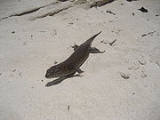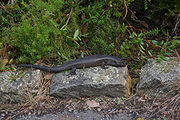
Egernia kingii
Encyclopedia
Egernia kingii, King's Skink, is a species
of skink
native to coastal regions of south-western Australia
common on Rottnest Island
and Penguin Island
and some coastal areas with open forest and open heath. It is a large, heavy-bodied black skink that can reach a length of 55 centimetres (22 in) with a mass of 220 grams (8 oz).
This reptile is omnivorous and consumes mostly softer plant matter from the range of local vegetation, but supplements its diet with insect
s and bird
's eggs. They are prey for many animals including Tiger Snakes ('Notechis sp.).
A traditional name for the species is Wandy, given by the Nyungar people of south west Western Australia. The first European to draw a King's Skink was the artist and naturalist Ferdinand Bauer
who made a detailed drawing of one during Flinders
' expedition in 1801.
Like many skinks, they are viviparous
and after a gestation
period of 20 - 22 weeks.give birth to litters of 2 - 8 young that have a typical mass of 7 gram (0.246917734735784 oz). Juvenile mortality is high and growth to adult size is slow, so mature King's Skinks can be quite long lived.

Species
In biology, a species is one of the basic units of biological classification and a taxonomic rank. A species is often defined as a group of organisms capable of interbreeding and producing fertile offspring. While in many cases this definition is adequate, more precise or differing measures are...
of skink
Skink
Skinks are lizards belonging to the family Scincidae. Together with several other lizard families, including Lacertidae , they comprise the superfamily or infraorder Scincomorpha...
native to coastal regions of south-western Australia
Australia
Australia , officially the Commonwealth of Australia, is a country in the Southern Hemisphere comprising the mainland of the Australian continent, the island of Tasmania, and numerous smaller islands in the Indian and Pacific Oceans. It is the world's sixth-largest country by total area...
common on Rottnest Island
Rottnest Island
Rottnest Island is located off the coast of Western Australia, near Fremantle. It is called Wadjemup by the Noongar people, meaning "place across the water". The island is long, and at its widest point with a total land area of . It is classified as an A Class Reserve and is managed by the...
and Penguin Island
Penguin Island (Western Australia)
Penguin Island is a 12.5 ha island off the coast near Perth Western Australia, 700 m from Rockingham. It is home to a colony of Little Penguins, the largest population of the birds in Western Australia. The waters surrounding the island make up the Shoalwater Islands Marine Park...
and some coastal areas with open forest and open heath. It is a large, heavy-bodied black skink that can reach a length of 55 centimetres (22 in) with a mass of 220 grams (8 oz).
This reptile is omnivorous and consumes mostly softer plant matter from the range of local vegetation, but supplements its diet with insect
Insect
Insects are a class of living creatures within the arthropods that have a chitinous exoskeleton, a three-part body , three pairs of jointed legs, compound eyes, and two antennae...
s and bird
Bird
Birds are feathered, winged, bipedal, endothermic , egg-laying, vertebrate animals. Around 10,000 living species and 188 families makes them the most speciose class of tetrapod vertebrates. They inhabit ecosystems across the globe, from the Arctic to the Antarctic. Extant birds range in size from...
's eggs. They are prey for many animals including Tiger Snakes ('Notechis sp.).
A traditional name for the species is Wandy, given by the Nyungar people of south west Western Australia. The first European to draw a King's Skink was the artist and naturalist Ferdinand Bauer
Ferdinand Bauer
Ferdinand Lucas Bauer was an Austrian botanical illustrator who travelled on Matthew Flinders' expedition to Australia.-Biography:...
who made a detailed drawing of one during Flinders
Flinders
There are many places with the word Flinders in their name. Most of these are in south-east Australia and are named for explorer Matthew Flinders.Flinders may refer to:Places* Cape Flinders, in the northern Canadian territory of Nunavut...
' expedition in 1801.
Like many skinks, they are viviparous
Vivipary
Vivipary has two different meanings. In animals, it means development of the embryo inside the body of the mother, eventually leading to live birth, as opposed to laying eggs...
and after a gestation
Gestation
Gestation is the carrying of an embryo or fetus inside a female viviparous animal. Mammals during pregnancy can have one or more gestations at the same time ....
period of 20 - 22 weeks.give birth to litters of 2 - 8 young that have a typical mass of 7 gram (0.246917734735784 oz). Juvenile mortality is high and growth to adult size is slow, so mature King's Skinks can be quite long lived.


